« May 2006 | Main | August 2006 »
July 31, 2006
Hypertrophic Cardiomyopathy
DISEASE OVERVIEW:
o Hypertrophic cardiomyopathy (HCM) has classically been defined as hypertrophy of the myocardium greater than 1.5 cm without an identifiable cause.
o The disorder has a variable presentation and carries a high incidence of sudden death.
Statistics:
o The mortality rate for individuals with HCM is 4% per year.
o HCM is slightly more common in males than in females.
o HCM usually presents at an earlier age in females than in males.
Signs and Symptoms:
o patients with HCM may be asymptomatic.
o symptoms of HCM can include sudden cardiac death
o dyspnea
o syncope
o presyncope
o angina
o palpitations
o orthopnea
o dyspnea
o congestive heart failure
o dizziness
Death often is sudden and unexpected and typically is associated with sports or vigorous exertion. (see young athlete at the figure)
Physical Findings:
o The classic auscultatory finding for HCM is a crescendo-decrescendo systolic murmur along the left sternal border that increases with the Valsalva maneuver, (See the young athlete that is more powerfull while standing and with valsava maneuver, similarly squatting and hand grip decreases his power and the intensity of his murmur).
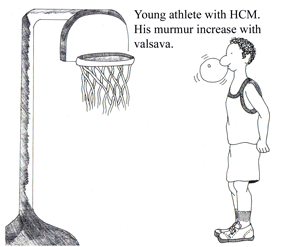
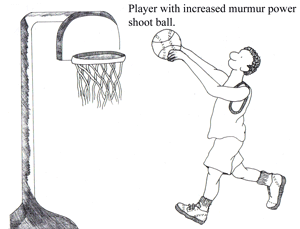
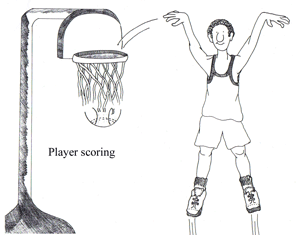
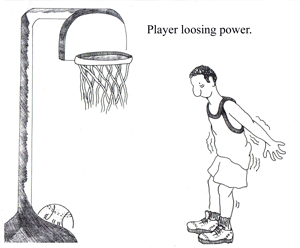
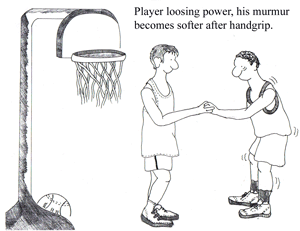
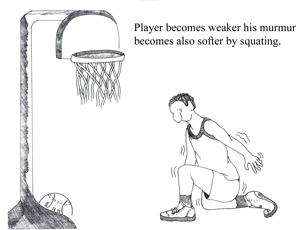
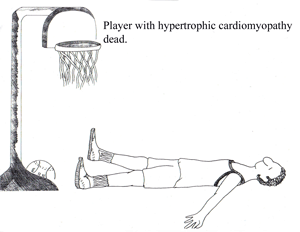
Imaging Studies:
o Two-dimensional echocardiography reveals LV hypertrophy and is diagnostic for HCM.
Procedures:
o Cardiac catheterization
o Electrophysiology studies
Surgical Care:
o Left ventricular myomectomy.
o Pacemaker implantation
o Catheter septal ablation
o Implantable cardioverter defibrillator
Posted by mmw at 07:24 PM | Comments (0)
July 30, 2006
Syringomyelia
DISEASE OVERVIEW
Syringomyelia is a clinical syndrome created by a cavity which forms within the spinal cord resulting in the destruction of segmental neurons and long ascending and descending tracts passing through the involved spinal segments. The cavity which forms within the spinal column is called a syrinx (Gr: pipe). A syrinx is cavity is like a pipe or syringe within the gray matter of the spinal column. The two types of syringomyelia are hydromyelia (communicating) and posttraumatic syringomyelia (noncommunicating). The course is usually chronic and progressive.
TYPES
• Posttraumatic: occurs in approximately 3% of patients with spinal cord injury
SIGNS and SYMPTOMS
• Symptoms usually begin in the hands and arms (note swimmer diving in hands first)* because of the involvement of the central lower cervical spinal cord.
• Hyporeflexia in upper extremities: due to destruction of the dorsal horn fibers from muscle stretch receptors
• Loss of pain and temperature perception (hands and arms): destruction of dorsal horn fibers from pain receptors
• Position, vibration, and touch sensation are usually preserved
• Upper extremity muscle weakness and atrophy: destruction of motor neurons and the anterior gray horns
• Lower extremity spastic weakness: occurs as long ascending and descending pathways are compressed by the expanding syrinx
• As the syrinx increases in diameter, long ascending and descending pathways passing through the involved cord segment are compressed or invaded by the cavity and cause spastic weakness of the legs. Tracts to and from the sacral bladder centers are spared, or involved late in the disease, so that bladder symptoms occur late or not at all.
• Central neuropathic pain
• Headache and neck pain
• Autonomic symptoms (interruption of intermediaolateral column): Horner’s syndrome and trophic changes of the skin
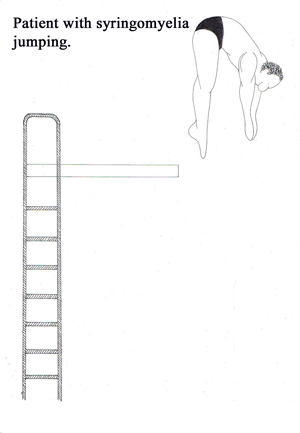
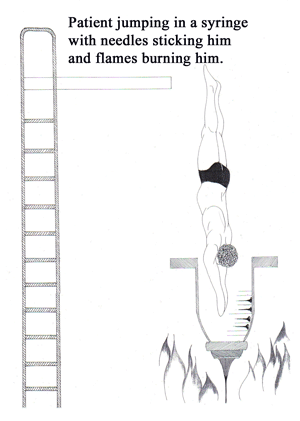
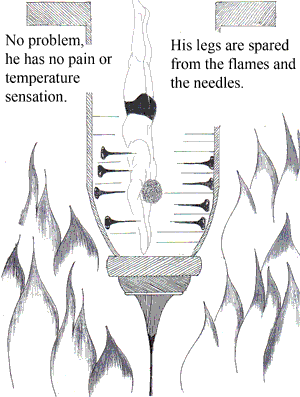
DIAGNOSIS
• Spinal MRI with contrast : reveals a central spinal cord cavity
• Electrophysiology: denervation in affected segments
TREATMENT
• Neurosurgical: Budd Chiari malformation – foramen magnum decompression
Posttraumatic - shunt
Posted by mmw at 06:28 PM | Comments (0)
July 10, 2006
Multiple Endocrine Neoplasia (MEN)
Multiple Endicrine neoplasia: A group of heritable syndromes characterized by abherant growth of benign or malignant tumors in a subset of endocrine tissues.
• Types
o MEN I: tumors involving the parathyroid glands; endocrine pacreas; and the pituitary
o MEN IIA: medullary carcinoma of the thyroid gland; pheochromocytoma; and hyperparathyroidism
o MEN 2B: medullary carinoma of the thyroid; multiple neuromas; and pheochromocytoma
MEN I (Wermer’s syndrome)
• Autosomal dominant
• 2-20/100,000
• features:
o hyperparathyroidism*
o enteropancreatic tumors (gastrinomas/Zollinger-Ellison syndrome; VIPomas; glucagonomas; insuilinomas)**
o pituitary adenomas (prolactinomas)***
o adrenal adenomas
o carcinoid tumors
o facial angiofibromas
*Note: Predator attacking victim’s parathyroid (hyperparathyroidism)gland by grasping either side of the victim’s neck
**Note: Predator attacking the victim by kicking him to the abdomen inducing tumors.
***Note: Predator attacking the victim’s pituitary gland by poking the victim between his eyes inducing pituitary adenoma.
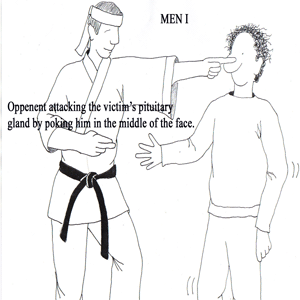
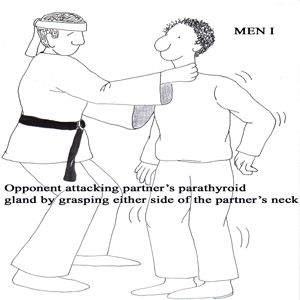
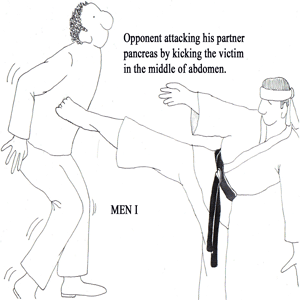
• Symptoms are related to the respective tumors
• Treatment
o Hyperparathyroidism
• Partial or total resection of parathyroid glands
• Prophylactic thymectomy
o Gastrinomas
• Proton pump inhibitors
• Correction of hypercalcemia
MEN II
• Autosominal dominant
• 1-10/100,00
MEN IIA (Sipple’s syndrome)-like sheep
• features
o medullary carcinoma of the thyroid (80-100%)*
• calcitonin producing parafollicular cells
o hyperparathyroidism**
o pheochromocytoma (50%)
• Hypertension; headache; palpitations; diaphoresis
• Super-strength demonstrated by the sheep after conquering the victim indicates the elevated catacholamines ***
o Hirschsprung’s disease
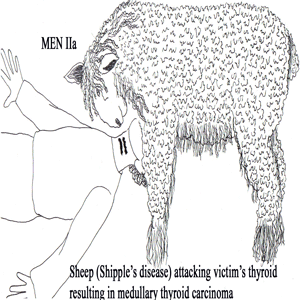
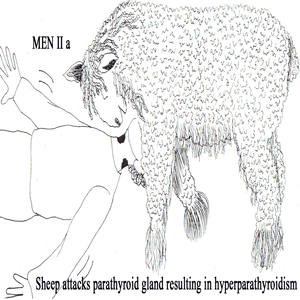
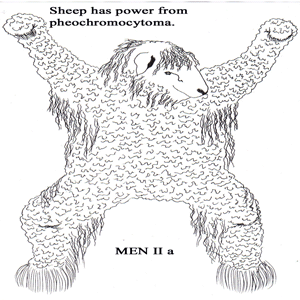
*Note: Sheep attacking victim’s thyroid resulting in medullary thyroid carcinoma
**Note: Sheep attacks parathyroid gland resulting in hyperparathyroidism
***Note: Sheep has power after eating the very nutritional thyroid and parathyroid organs and develops pheochromocytoma
MEN IIB (MEN III)
• Features
o Medullary carcinoma of the thyroid*
o Pheochromocytoma**
o Marfanoid body habitus
o Multiple neuromas of the conjunctiva; lips; labia; tongue; mucosa; larynx***
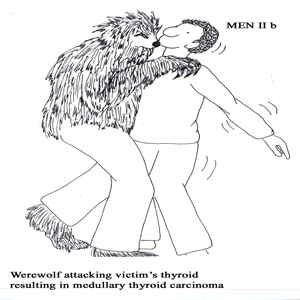
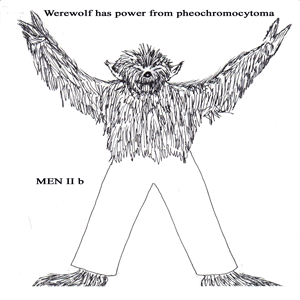
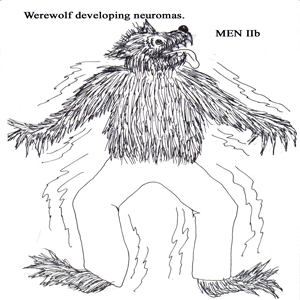
*Note: Werewolf attacking victim’s thyroid resulting in medullary thyroid carcinoma.
**Note: Werewolf now becomes very powerfull immediatelly, and develops pheochromocytoma after eating the thyroid gland.
***Note: Werewolf develops neuromas from all the energy produced from the pheochromocytoma.
Posted by mmw at 03:16 PM | Comments (0)